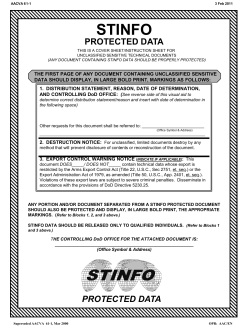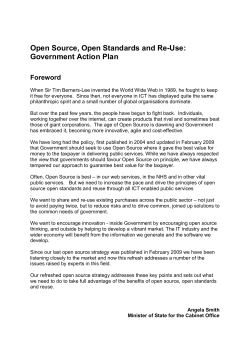
Reference Architecture for IT Optimization
Reference Architecture for IT Optimization 5 January 2012 – DoDAF Plenary Brian Wilczynski Director, Architecture & Infrastructure Office of the DoD CIO Brian.Wilczynski@osd.mil UNCLASSIFIED Agenda The DoD Architecture Framework Reference Architectures The DoD Information Enterprise Architecture IT Enterprise Strategy and Roadmap Data Center Consolidation and Network Optimization Reference Architectures (RA) UNCLASSIFIED 2 DoDAF Evolution DoDAF 1.0 • Program – Level Focus • Volume III was A Deskbook • CADM was Separate • Baseline for DoDAF 1.5 DoDAF 1.5 • Began to address Net-Centricity • Program – Level Focus • Volume III is CADM & Architecture Data Strategy • Addressed Architecture Federation • Baseline for DoDAF 2.0 (Published in 2003) (Published in 2007) DoDAF 2.0 (Published 2008) UNCLASSIFIED DoDAF 2.0 • Covers Enterprise through Program Architecture Spectrum • Documents High Level Guidance • Web-based • On-Line Journal - Best Practices - Errata Sheets - Interim Releases - New Requirements - Usage Examples • Fit For Purpose Content & Presentation 3 Reference Architectures “A Reference Architecture is an authoritative source of information about a specific subject area that guides and constrains the instantiations of multiple architectures and solutions” The DoD‐wide Reference Architecture provides information, guidance, and direction that is applicable across DoD. This information, guidance, and direction are provided in the five (5) elements that comprise a Reference Architecture: – – – – – Strategic Purpose – Identifies goals and objectives of the Reference Architecture and describes the specific purpose of and the problem(s) to be addressed by the Reference Architecture. Principles – Sufficient high level foundational statements of rules, culture, and values that drive technical positions and patterns. Technical Positions – Technical guidance and standards, based on specified principles that need to be followed and implemented as part of the solution. Patterns (Templates) – Generalized architecture representations (viewpoints, graphical/textual models, diagrams, etc.) that show relationships between elements and artifacts specified by the technical positions. Vocabulary – Acronyms, terms, and definitions that are used in the Reference Architecture and are relevant to architectures and solutions that are guided and constrained by the Reference Architecture. UNCLASSIFIED 4 Reference Architecture Concept Reference Architecture Description (Approved 24 Aug 2010) Enterprise-wide Access to Network and Collaboration Services Strategic Purpose Principles Reference Architecture Overview and Summary Information (AV-1) 1 Architecture Product Identification 1.1 Name: Enterprise-wide Access to Network and Collaboration Services (EANCS) Enterprise-wide Capabilities DRAFT 1.2 Lead Organization: Department of Defense Deputy Chief Information Officer. The Enterprise Services Review Group (ESRG), as the architecture owner, is responsible for architecture content and will provide overall coordination to ensure appropriate stakeholders and subject-matter experts are available; the Enterprise Reference Architecture Cell (ERAC), with oversight from the Architecture and Standards Review Group (ASRG), will support the development of appropriate architecture artifacts. 1.3 Approval Authority: DoD CIO Enterprise Guidance Board (EGB) 2 Purpose and Perspective 1 2.1 Purpose. A Reference Architecture (RA) abstracts and normalizes the institutional understanding of capabilities at the enterprise level, and provides a common set of principles, technical positions, and patterns for use within the DoD to guide development of Enterprise, Segment, or Solution architectures. DRAFT Reference Architectures 2 3 4 5 6 2 3 4 7 5 8 6 9 7 10 Department of Defense DRAFT 1 8 1 Department Defenseand Enterprise-wide Access to of Network 2 Collaboration Services (EANCS) 3 Department Defenseand Enterprise-wide Access to of Network 4 Collaboration Services (EANCS) Reference Architecture 5 Enterprise-wide Access to Network and 6 Collaboration Services (EANCS) Reference Architecture 11 9 7 12 10 8 13 11 9 14 12 10 15 13 11 16 14 12 17 15 13 18 16 14 19 17 15 20 18 16 21 19 17 22 20 18 23 21 19 24 22 20 25 23 21 26 24 22 27 25 28 29 OV-1 (Concept – Consumer & Provider) OV-6a (Operational Rules Model) Patterns OV-5a (Activity Decomposition) Version 3.0 December 2009 Version 3.0 December 2009 Version 3.0 Prepared by the Office of the DoD CIO 27 OV-6c (Event-Trace Description) December 2009 28 29 Technical Positions EANCS RA StdV-1 Standards Profile Reference Architecture 23 26 24 Prepared by the Office of the DoD CIO 27 25 28 26 29 AV-1 (Overview and Summary) GROUP OMB TYPE Policy NAME M-04-04 OMB Policy M-05-05 OMB Policy M-05-24 OMB Policy M-06-18 Presidential Directive Policy HSPD-12 NIST Guidance SP 800-87 DESCRIPTION This guidance requires agencies to review new and existing electronic transactions to ensure that authentication processes provide the appropriate level of assurance. It establishes and describes four levels of identity assurance for electronic transactions requiring authentication. Assurance levels also provide a basis for assessing Credential Service Providers (CSPs) on behalf of Federal agencies. This document will assist agencies in determining their egovernment needs. Agency business-process owners bear the primary responsibility to identify assurance levels and strategies for providing them. This responsibility extends to electronic authentication systems. This memo requires the use of a shared service provider to mitigate the risk of commercial managed services for public key infrastructure (PKI) and electronic signatures. This memorandum provides implementing instructions for HSPD-12 and FIPS-201. This memorandum provides updated direction for the acquisition of products and services for the implementation of Homeland Security Presidential Directive-12 (HSPD-12) “Policy for a Common Identification Standard for Federal Employees and Contractors” and also provides status of implementation efforts. HSPD-12 calls for a mandatory, governmentwide standard for secure and reliable forms of ID issued by the federal government to its employees and employees of federal contractors for access to federally-controlled facilities and networks. This document provides the organizational codes for federal agencies to establish the Federal Agency Smart Credential Number (FASC-N) that is required to be included in the FIPS 201 Card Holder Unique Identifier. SP 800-87 is a companion document to FIPS 201. StdV-1 (Standards Profile) Prepared by the Office of the DoD CIO Vocabulary UNCLASSIFIED AV-2 (Integrated Dictionary) 5 DoD Information Enterprise Architecture Purpose: – Unifies the concepts embedded in the DoD’s net-centric strategies into common vision – Describes the integrated Defense Information Enterprise and the rules for information assets and resources that enable it – Fosters alignment of DoD architectures with the enterprise netcentric vision Integration of NCOW RM content Appendix D: Applying the DoD IEA Appendix E: Compliance with the DoD IEA Appendix G: Requirements for Compliance to the DoD EA Available at: http://dodcio.defense.gov/sites/diea/ UNCLASSIFIED 6 DoD IEA v2.0 Conceptual Depiction of the DoD Information Enterprise UNCLASSIFIED 7 IT Enterprise Strategy & Roadmap UNCLASSIFIED UNCLASSIFIED 8 Federal Data Center Consolidation Initiative (FDCCI) • • OMB Federal Data Center Consolidation Initiative memo dated 2/26/2010 Overall goals are: – – – – • • Green IT – reduce overall energy and real estate footprint Reduce cost of data center hardware, software and operations Increase overall IT security posture of government; and Shift IT investments to more efficient computing platforms and technologies Deliverables – Initial Asset Inventory: High-level understanding of scale and size of existing data centers, IT infrastructure assets, and applications. – Initial Data Center Consolidation Plan: Potential areas for consolidation. High-level roadmap for transitioning to consolidated end-state architecture. – Final Asset Inventory Baseline: Foundation for developing final data center consolidation plans. – Final Data Center Consolidation Plan: Technical roadmap and approach for achieving the targets for infrastructure utilization, energy efficiency, and cost efficiency. Next Steps – Ongoing Monitoring: Report inventory annually by Q3 of each FY; consolidation plan execution progress quarterly, and reflect changes in asset inventories and account for execution of data center consolidation plans in budgets. UNCLASSIFIED 9 Today’s Data Center Environment DISA USAF DON USA Data Center to Stay Open Data Center to be Closed Regional/Component Data Centers Optimized by Services/Agencies to Gain Efficiencies UNCLASSIFIED 10 Data Center Optimization Global Footprint Data Centers will be closed, by repositioning servers and virtualizing, while simultaneously establishing a Federation of Resilient CORE Data Centers with Robust Inter-connectivity and Global Accessibility CORE Data Centers would be Exemplar Data Center Standard Compliant Supporting “Cloud Computing” based Foundational & Common Enterprise Services UNCLASSIFIED 11 Data Center & Server Consolidation Reference Architecture (DC&SC RA) Conceptual Core Computing Center UNCLASSIFIED Defines & standardizes attributes for Core DoD Computing Centers integrating DoD cloud and server virtualization concepts, rules & standards Defines cloud delivery mechanisms (SaaS, PaaS, IaaS) for DoD Enterprise Services Leverages Defense ITIL for management of the GIG Computing Environment DC&SC RA Version 1.0 is scheduled for release in Q2FY12 12 Network Optimization RA (NORA) Purposes & Objectives Common Network Army Navy Navy Marine Corps Air Force Other DISN Backbone Army Marine Corps Air Force DISN Backbone Network Enclaves Other 13 Questions 14
© Copyright 2025















